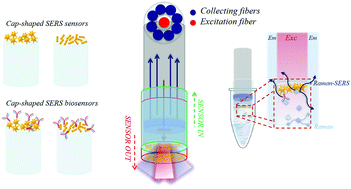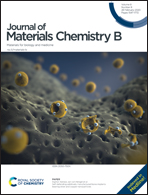Fiber-cap biosensors for SERS analysis of liquid samples†
Abstract
Optical detection techniques based on surface enhanced Raman spectroscopy (SERS) are a powerful tool for biosensing applications. Meanwhile, due to technological advances, different approaches have been investigated to integrate SERS substrates on the tip of optical fibres for molecular probing in liquids. To further demonstrate the perspectives offered by SERS-on-fiber technology for diagnostic purposes, in this study, novel cap-shaped SERS sensors for reversible coupling with customized multimodal probes were prototyped via low-cost polymer casting of polydimethylsiloxane (PDMS) and further assembly of gold nanoparticles (Au NPs) of varied sizes and shapes. To demonstrate the feasibility of liquid sensing with cap sensors using backside illumination and detection, the spectra of rhodamine were acquired by coupling the caps with the fiber. As expected by UV-vis, the highest SERS efficiency was observed for NP-decorated substrates with plasmonic properties in resonance with the irradiation wavelength. Then, SERS biosensors for the specific detection of amyloid-β (Aβ) neurotoxic biomarkers were realized by covalent grafting of Aβ antibodies. As attested by fluorescence images and SERS measurements, the biosensors successfully exhibited enhanced Aβ affinity compared to the bare sensors without ligands. Finally, these versatile (bio)sensors are a powerful tool to transform any milli-sized fibers into functional (bio)sensing platforms with plasmonic and biochemical properties tailored for specific applications.



 Please wait while we load your content...
Please wait while we load your content...